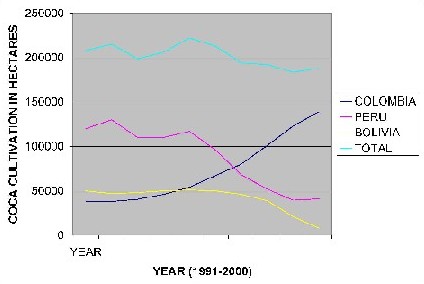Editorial:
Weak
Claims
of
Success
5/20/05
David Borden, Executive Director, [email protected], 5/20/05
Not so fast. Some experts believe the coca is more potent now due to improved agricultural techniques by the drug trafficking organizations, and economic evidence here in the US backs them up. The drug warriors' own theory says that the strategy is to reduce the supply of drugs in order to increase their price and decrease their availability. I happen to think that's too much of a simplification to be very useful if what we are really interested in is reducing the harm connected with drug abuse and not just use irrespective of whether it constitutes abuse. A price increase and availability decrease can actually cause more harm, by driving addicts to more desperate measures and increasing the enrichment of criminal organizations. But that's their theory, and unfortunately for them prices have instead gone down while availability has stayed the same or increased. According to a RAND Corporation report commissioned by Walters and released last February, the price of a pure gram of powder cocaine fell from $161 in 2000 to $107 in 2003, while the price of a pure gram of crack cocaine fell from $219 to $190 -- the opposite of what supply reduction is supposed to achieve. Also in February, the Trends and Development report of the National Drug Intelligence Center found that "key indicators of domestic cocaine availability show stable or slightly increased cocaine availability in drug markets throughout the country" -- also inconsistent with a shrinking supply. Not signs of success according to the drug warriors' own key measure.
Data from the INCSR (International Narcotics Control Strategy Report) between 1990 and 2000 paint a revealing picture. (Pardon my poor graphical skills -- if anyone wants to help us make a better chart please send an e-mail.) The decade of the Bush-Clinton Andean drug war saw a dramatic decrease in coca growing in Peru and Bolivia but an equally dramatic increase in Colombia. The total estimated number of hectares cultivated (100 hectares = 1 square kilometer) changed a little but not very much -- it went up slightly, then went down slightly in total -- basically it stayed the same. Whatever small change took place was a fraction of the amount that shifted from country to country -- a pretty dramatic illustration of suppression in one area causing growing to balloon up in others as global supply follows global demand. So dramatic, so powerful, I think, as to project any hopes of current or future supply reduction successes as extremely unlikely. The economic forces are just too powerful. Too many people are willing to pay too much money for cocaine to control its use in that way. The government will always fail to stymie the drug supply, because it just isn't possible to control it. So the claims of success are pretty weak, and that's not just dishonest of John Walters, it's immoral. From eradication in the Andes to no-knock warrants in the inner cities, from needle-driven HIV to mandatory minimum sentences, too many people are being harmed by reckless drug war policies, partly because bureaucrats have enabled their continuation by obfuscating the truth to rationalize the unjustifiable. These are not small lies, but large and noxious ones. The drug czar should stop fudging numbers and start letting people live their lives.
|


